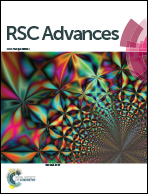Tunable electronic and dielectric properties of β-phosphorene nanoflakes for optoelectronic applications†
Abstract
Since the discovery of α-phosphorene, it has drawn considerable attention because of its possible exfoliation as single layers. We report electronic and dielectric properties of β-phosphorene nanoflakes in various configurations using density functional theory. Armchair edge nanoflakes with various shapes are magnetic semiconductors while hydrogen passivated edge structures are non-magnetic semiconductors with energy gap in the range of ∼2.3–2.7 eV which is suitable for solar cell applications. Dielectric functions are highly anisotropic in the low energy range and become isotropic above 10 eV energy. The calculated static dielectric constant shows strong dependence on the shape and edge structure of the considered nanoflakes. We found significantly large plasmonic energy differences for nanoflakes with a particular shape but having different edge configurations. Our results demonstrate that electron energy loss spectroscopy may be useful to determine the various shapes and edge configurations of β-phosphorene nanoflakes. The tunable energy gap and dielectric response make the considered nanoflakes potential candidates for optoelectronic device applications.


 Please wait while we load your content...
Please wait while we load your content...